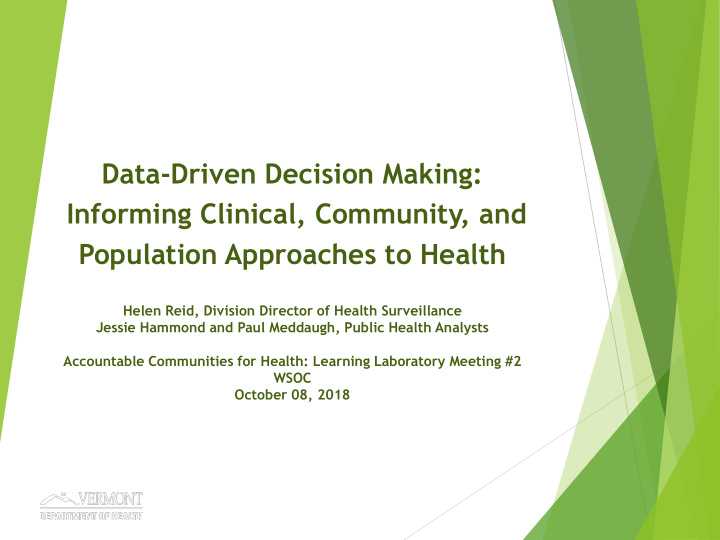



Data-Driven Decision Making: Informing Clinical, Community, and Population Approaches to Health Helen Reid, Division Director of Health Surveillance Jessie Hammond and Paul Meddaugh, Public Health Analysts Accountable Communities for Health: Learning Laboratory Meeting #2 WSOC October 08, 2018
9 Core Elements of an Accountable Community for Health Model 1. Mission 2. Multi-Sectoral Partnership 3. Integrator Organization 4. Governance 5. Data and Indicators 6. Strategy and Implementation 7. Community Member Engagement 8. Communications 9. Sustainable Funding 2
Data, Data, Everywhere… Vermont Department of Health
FOUNDATIONAL CONCEPTS: POPULATION HEALTH IMPACTS 4
Broaden Scope to Include All 3 Streams Upstream - Structural Factors Mid-stream - Social Determinants Downstream - Health Care Outcomes This Photo by Unknown Author is licensed under CC BY-SA 5
Importance of data driven decision making in Accountable Communities for Health We are all working towards understanding our communities better The challenges and problems they face Identifying and prioritizing problems, opportunities, and goals Monitoring progress and change Communicating back to our community about what is being done and who is better off as a result. Data can help us do all of the above
What data to use, where to start When thinking about ACH, we don’t just compile all of our measures We want to use the right types of data/information at the right time for the right activities Used together, quantitative and qualitative data can enrich and deepen what we know
What type of data? Quantitative Health Care Encounters Clinical Claims Hospital Discharge and Emergency Visits Registries Cancer Immunization Vermont Prescription Monitoring System (VPMS) Population Vital Statistics Surveys (e.g., BRFSS, YRBS, PRAMS) Community Community resources (e.g., physical activity access in community) Data collected as part of a local program or effort (e.g., community survey) Qualitative Focus groups Interviews
Ways to use data Depending on where an ACH is within its lifespan, members may be: Identifying trends 1305 Surveillance Data Pages Prevalence of gestational diabetes, all Vermont births (Vitals, pg. 32 ) Prevalence of Cardiovascular Disease, Adults (BRFSS, pg. 47) Hospital Discharges with CVD Diagnosis, Rate per 10,000 Vermonters (Hospital Discharge Data, pg. 48 ) % of Insured Vermont Adults 18-64 with Hypertension who are at Least 80% Adherent with their Antihypertensive Medication Regimen (VHCURES, pg. 68) Assessing needs State Health Assessment (SHA) Health equity lens Vermont CHNA Community Profile (HSA & DO Versions) Breast Cancer Incidence Rate per 100,000 women (NPCR) % of adults with cholesterol check in last 5 years (BRFSS) % of adolescents who do not eat 5 fruits & vegetables per day (YRBS) PCP FTEs per 100, Vermonters (Health Care Workforce Census)
Ways to use data Depending on where an ACH is within its lifespan, members may be: Establishing Measures State Health Improvement Plan (in-progress) Prioritize topics and populations based on SHA Healthy Vermonters 2020 (including Performance Scorecard) Coronary Heart Disease Death Rate per 100,000 Vermonters (Vitals) % of Children with Developmental Screening by Age 3 (Blueprint) # of Vermonters with diabetes who complete a Healthier Living Workshop – Diabetes (program data) # of registrants to the 802 Quits Quitline (program data) Setting and Measuring Progress Towards Goals Heart Disease Prevention Goal Tracker Decrease % of Vermont adults with high blood pressure who smoke (BRFSS) Increase % of insured Vermonters 18-64 with diagnosed high blood pressure who have at least one primary care visit for high blood pressure in last year (VHCURES) Decrease % of adults with high blood pressure who have no leisure time physical activity (BRFSS)
Example of Using Data Short Term Mid Term Long Term (Process) (Outcome) • Decrease % of • Decrease • # of registrants to adults with deaths due to 802 quits quitline high BP who Coronary Heart • # of registrants smoke Disease with HLW-D self- • Decrease management hospitalization program s with CVD diagnosis
When working with data remember…. Different types of data for different things Process vs. Outcome Short vs. Mid. vs. Long-Term Multiple sources and perspectives Health care encounters vs. Population Qualitative vs. Quantitative
Vermont Department of Health
Vermont Department of Health
Vermont Department of Health
Vermont Department of Health
Vermont Department of Health
Vermont Department of Health
Recommend
More recommend